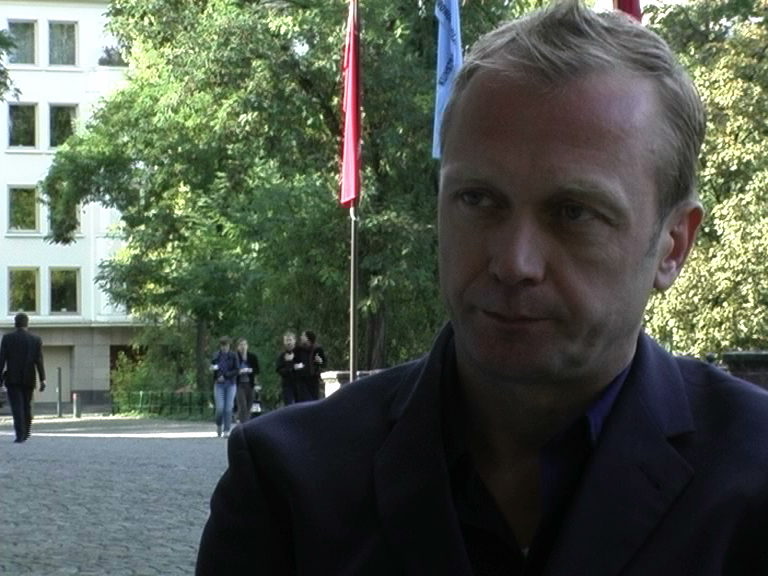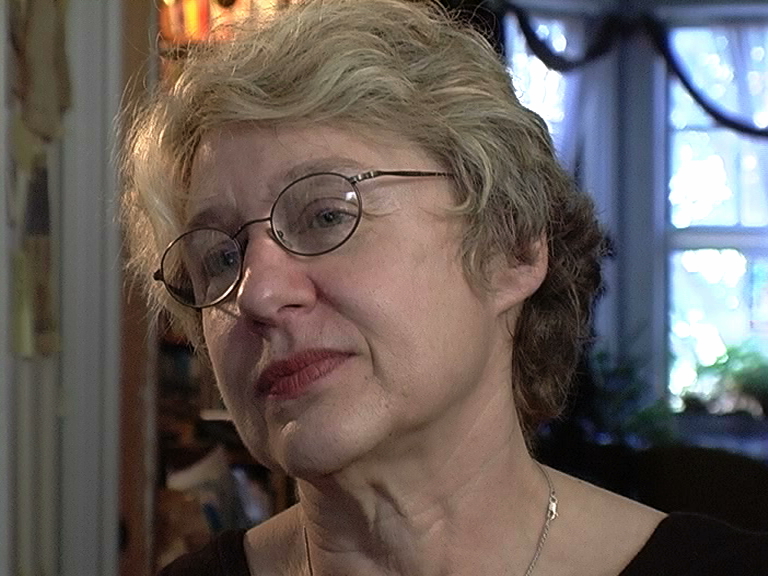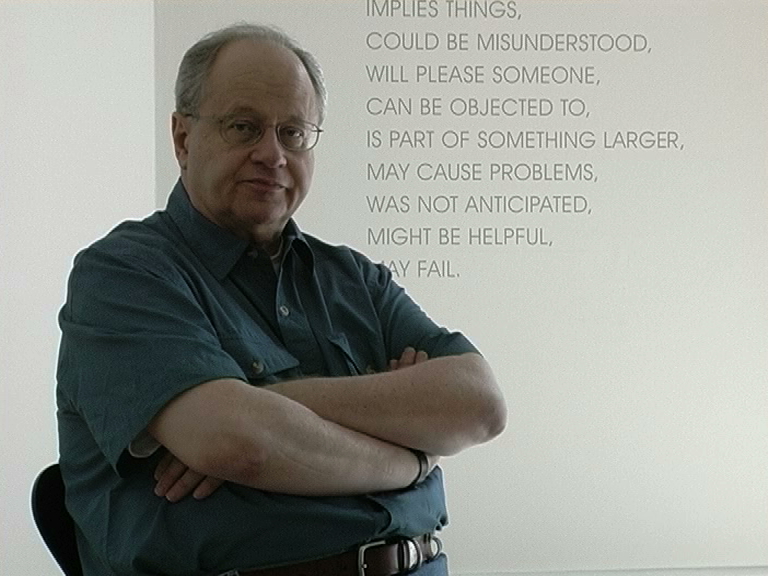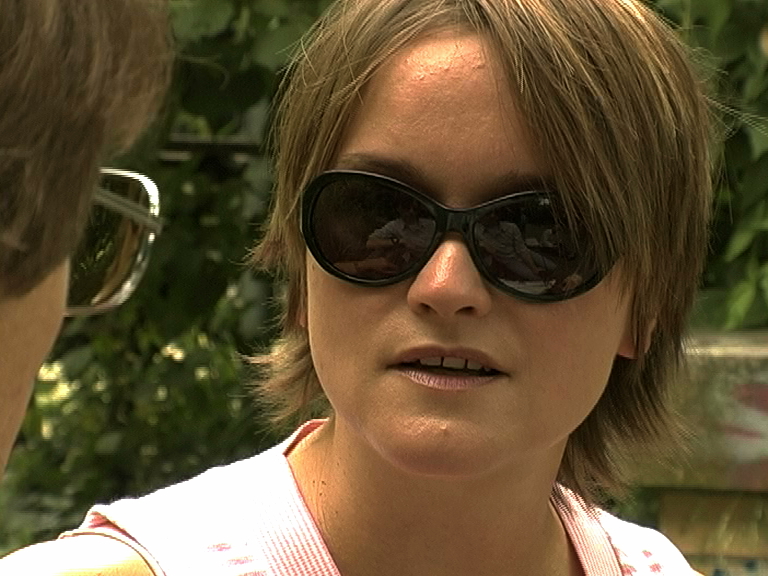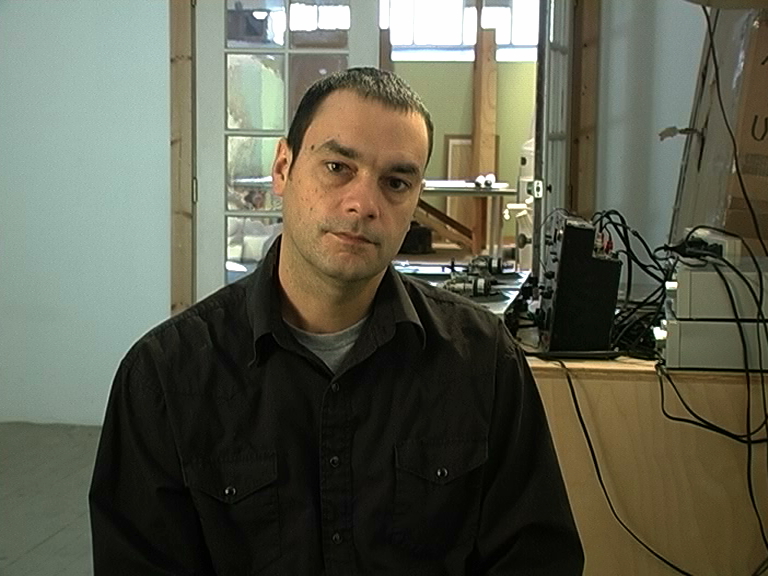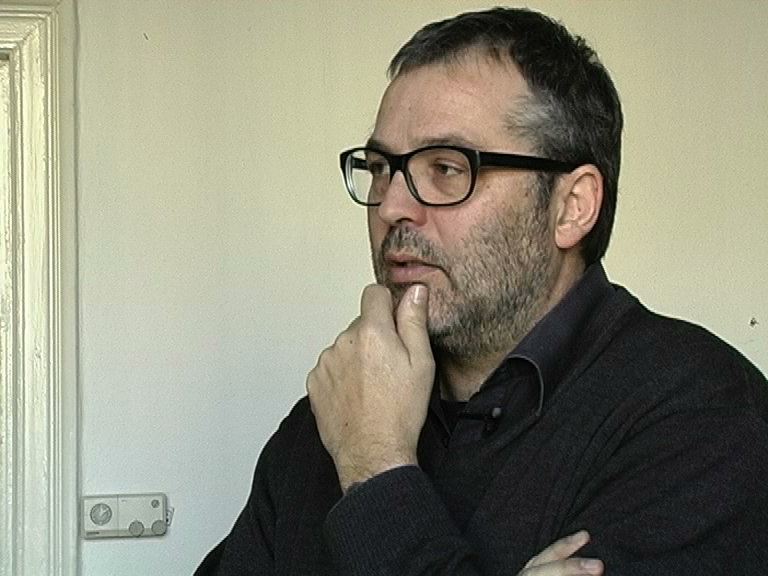Robert Barry
Kunsthalle, Nürnberg 15.09.2003
read the interview
S.R.: I’m especially interested in the influence. How does the movement of Conceptual art, how does it start? Where was the influence. Now we have some different questions about that and it’s also a little bit about the anxiety of influence. Because in art history there is a kind of a rupture with Conceptual art. Ok, there was Pop art, there was Minimal art. But then Conceptual art for sure was something like a rupture. It was a totally cut with the idea of originality, with the idea of an author who is preparing the original etc.
R.B.: The thing about it is, I don’t know what your question is. What is your question exactly? (Unterbrechung) But I would not call it Conceptual art. This was not something I thought about at all. And it was really a little bit later that the term came about; it’s not a term I liked. In fact I only know a couple of artists who liked the term Conceptual art, certainly Weiner doesn’t like it. It was Kosuth or Art&Language, and they had a very specific meaning to it. It wasn’t a term that I thought of applying to me at all.
S.R.: Was there any specific term?
R.B.: No. I never liked that kind of boxing-in by category. I knew that if I called myself a Conceptual artist in the beginning, I would absolutely be trapped in that term. And it was not something that I wanted to do. And there was always, by the way, a physical aspect to what I did, even though that physical aspect may just be in your mind; that notion of time or space or something like that was always something that I had in my work. So it wasn’t just something conceptual like that. It was not a term that I liked very much and it was not a term that I used about myself.
S.R.: Maybe we can come back to this issue. And I have another question about your influences and that is: What was – apart from Conceptual art – the strongest influence on your work?
R.B.: I think David Smith said that he’s been influenced by everything he ever saw, and I would say that I’ve been influenced by everything that I’ve ever seen and heard. I can’t think of any one specific thing that influenced me. My own work influenced me; I would always look back on what I had just done and see if I could move past that. Certainly there were artists that I liked, but to pick out some influence––I don’t think I could do it, I can’t point to somebody‘s work or something like that, that influenced me. It was always a very personal choice based on what I had done before, and sometimes I would go back to earlier work and see whether I could develop from that. Certainly I was reading a lot, I was looking at a lot of other artists‘ work, but I’ve always done that. The artists that interested me were artists like Barnett Newman, Mark Rothko, Ad Reinhardt, people like that. But to say they influenced me, I cannot directly say; that would mean that I would have taken something from their work. The teachers that I had when I was at school were real artist, like Robert Motherwell, William Baziotes, Ray Parker, and I liked the way they thought and I liked the way they lived their lives and what the life of the artist was, and this was very interesting to me. I didn’t know if I wanted to be an artist when I went to school, to college. I didn’t go to an art school, I went to a liberal arts college, and I wasn’t sure if I wanted to be a writer or a music historian or an artist or what. I really hadn’t made this decision.But talking to artists and meeting them and discussing their work, and what art was about and thinking about art. Motherwell was something of a philosopher and a writer, and he was someone who thought about art, and I had very interesting conversations with him. I don’t think he was a great artist, really, but if you would say he was an influence, he influenced me in terms of the way I approached art from a very thoughtful point of view, a very critical point of view. I had a teacher, Tony Smith, who was in some ways influential, but influential in the way he thought about things, not in how I cover or form or how I create my work, but he had an interesting approach. He was very open to different ways of thinking about art; I liked the way he thought about art and thought about being an artist. But to say that there was some artist, some influence… I read a lot of Merleau-Ponty, I liked very much a little bit of Heidegger, but I think that they just reaffirmed what I was already thinking about in terms of art; I knew that I had to open up art, and not really try to imitate what had happened before me … So, one thing a tried to do was to really avoid falling into some way of thinking that had already been established, or taking some ideas; say Minimal art which was the most interesting art to me, and then pushing it very far, as far as I can go, and then seeing where that took me and where I could go from that. I think it had more to do with the way I approach art than any kind of influence. I was interested in thinkers and music, Jazz, Bach, I would say someone like Miles Davis or Coltrane or Charlie Parker or Bach influenced me as much as any artist I can think of.
S.R.: Now we have a little bit of move in the question. Can you say or can you claim something that is the aim of your practice?
R.B.: The ultimate aim of my practice is to make something that is satisfying to me. Basically that’s it. But of course that’s based on my style and the way I think about things, and the way I approach life and art. Art is a reflection of the way I think about what’s important in life. My art has always been about being very intensively involved in the siutation that you are in. I think my work is about that. If I were to say something about my work, I’ve always tried to think about making art that doesn’t look like art, and I guess that’s a sort of a 60s or conceptual point of view. Today, if you look at what most young artists are doing, it’s a pretty conservative approach to art; if you look at it, okay, this is art and you can really point to the influences that they had, a kind of re-digging into the recent past and pulling out what they think they can use, and may be updating it and making a few changes. That’s not at all interesting to me as an artist. As an artist I think one can be a lot more challenged than that. I like to think that this is the way I approach it. Deep down, I really want to try and make something that no one has ever seen been before and will take seriously. I think that in the realm of art that’s something you can do – most people don’t do it––but I think it’s something you can do. In other realms of activity I don’t think you can get away with it, but in art you can get away with it. It’s all about re-learning how to look at things, because most of what we know we know by looking at something… from sight. If I can do something along those lines – then I think that’s the aim of what I’m trying to do. But ultimately I have to be satisfied by it myself and I try not to fall into a conventional pattern of thinking. I try not to be decorative about it. I think the art I make today is probably a little bit more conservative from the art I did thirty years ago, because there are certain things I’m trying to do which are a little bit different. I was really searching in this exhibition here the early work… there is a feeling of searching by the young guy who is trying to find his way and being very careful to avoid imitating anything around him. And open up some new way of thinking. I was basically trying to intrigue myself, to challenge myself and see what happens when I put it out into the public, see what the reaction is. When I put work out into the public, it’s not for satisfaction, it’s just to see what the reaction is from people. I’m basically satisfied by it, and, surprisingly, I find other people who are satisfied by it occasionally, not everybody, but occasionally some people are.
S.R.: Would you say that contemporary artists are aware of what has been done 30 years ago? Because there was one example circling around in my head as you said younger artists are researching history and things like that. Because ca. two years ago there was a couple doing an exhibition in a Berlin gallery Mehdi Chouakri, Plamen and Dejanov, they did a show in the time when the gallerist was on holiday. They wrote on the window: “the gallery keeps closed until the gallerist is back from his holiday” or something like that “…and this is our work” or something like that. It was just an idea this time, I think you made something like that in the beginning of the 70s in different galleries.
R.B.: “The closed gallery piece“, it’s out there.
S.R.: I know that these artists didn’t know anything about your work.
R.B.: I’m surprised Paul never told them. I don’t know. Some people do and some people don’t. I’m really not sure. My sense of the art world today is that it’s very consumer-driven, very collector-driven, that there’s a lot of money involved. Collectors are generally very conservative people, as are most gallerists. So the artists give the collectors what they want obviously and… When a market is driven like that I think that it’s going to be difficult to see a lot of innovative thinking and we really don’t get it. There’s some good art out there. I have problems with young artists, I really do, even young Conceptual artists. It kind of looks like the work of my students when I was teaching twenty years ago. To much of it looks like that and…
S.R.: Do you want to mention some names?
R.B.: No, I don’t talk about directly in public. Only in the bar at night, when we are talking privately. Artists have enough trouble surviving without having other artists put them down; whether you like their work or not. I leave that to critics. That doesn’t mean I can’t express my opinions about it, but I’m not going to do it in public or for print, publication.
S.R.: So, do you think that conceptual paradigms, if it’s possible to figure something like that out, do you think that conceptual paradigms are still in function?
R.B.: I think Conceptual art was very influential, but I think people don’t know it. They are doing things that the conceptual artists found, discovered and did, but it may actually be the most influential movement since Cubism, as far as I can say, but I think a lot of younger artists are absolutely unaware of what happened before. They picked up these ideas because these ideas because these ideas are in the air; they just become very commonplace about how to approach making art. And you see a lot of Conceptual art around, there is certainly a lot of group shows. I don’t know, if you see very much of it in the galleries. I’m not a person that visits galleries very much anymore, I usually find it a very disappointing experience, unless it’s a friend of mine or someone who’s very recommended by someone I trust. I generally don’t visit galleries. I’m not a good person to ask about what’s going on in the art world right now. It’s just what I see from thumbing through magazines and occasional group shows or visiting the Basel Art Fair because I have some dealers there, I have some business… I’m really not aware of what is happening. The Basel Art Fair is unfortunately an extremely commercial enterprise; what you see is what the dealers think is going to sell, and this is unfortunately very disappointing. With some exceptions, there is always a few exceptions. You see some good work, but it’s usually by artists of my generation I have to say. I think artists over 55 or 60 and in that area, the most beautiful works I see are artists who are around my age. I think they are still doing the most interesting and most innovative work.
S.R.: So you don’t think that there is a possibility to renew or re-invent something like conceptual thinking, conceptual…
R.B.: I wouldn’t want to do that. I really don’t. I’m looking for something that’s totally unexpected… for something I learn something from, and I don’t find it anywhere. If I can see something that I haven’t seen before and recognize it as art that I could be interested in. I just don’t see it. Maybe a while before… a flush-out of all of this crap that’s coming out now, may take another generation. I really don’t know. I’m not a critic, I’m not an art historian, so I don’t really think about those things. I’m just busy making my own work. It’s not something that I really explored very much. That’s a question for an art theorist or an art crtitic but not for an artist to worry about that. Artists are just too busy struggling to make their own work to worry about everybody else.
S.R.: I remember that one aspect of Conceptual art was called the art-critical aspect. For example Joseph Kosuth was writing art criticism, doing interviews with his colleagues, for example with you?
R.B.: Kosuth didn’t do any interviews. He wrote a lot of theory, most of which I don’t like very much. It’s very hard for me to read, because every time I read a sentence I say that’s completely wrong and I have an argument about it. I really don’t read much of what he said. I tend to not to like art with too many footnotes anyway. I like it to be a kind of direct and not have to read what somebody else tells me how to think about it. And the interviews that he did, if you are talking about the interviews like here in the interview piece or something like that, Kosuth didn’t do those interviews. All the interviews that I did or either with somebody like you or, if it was a piece it was an interview, I wrote myself. But Kosuth never interviewed me.
S.R.: But he published some interviews under a pseudonym I think.
R.B.: Arthur Rose? Those are not his interviews. Arthur Rose was a take-off from Duchamp, he doesn’t exist. And Siegelaub and the rest of us used this as a kind of publicity or as a way of making art.
S.R.: So it was written? It was not an interview?
R.B.: Yes, it was written. I composed the whole thing; the questions, the answers, everything. It was not an interview.
S.R.: This sounds very consequential to me. If you for example look at this book, which Alexander Alberro published half a year ago. Maybe the whole enterprise of Seth Siegelaub was something like an invention of a public relations‘ idea. And so the ideas of Conceptual art and the idea of his promoting art fused into one thing.
R.B.: Yes. You would have to discuss Siegelaub’s function in Conceptual art. Which is a very interesting function. It’s part dealer, part artists‘ helper, part publicist. I think he had a role like no other person, who ever existed. He was not an artist, he would be the first to say it, but he designed artists‘ books and he helped artists design the way they work looked, the way it’ll be presented, because so much of it was documentation. Seth was always very interested in publishing books. I think he was more interested in publishing than in being a dealer or in running a gallery. He likes publishing books. That’s what he does now, that’s what he did when he finished being a dealer. The idea of a book and presenting it and distributing it around the world was something that intrigued Seth very much. The idea putting information out in some kind of published form was an idea that Seth was always trying to do, and he applied it to art. So he worked with the artists in a very intimate way to present their work, and the idea of presentation became very interesting in that what the art ultimately was, was also how it was presented. The presentation had to do with the look and the eventual way that the work would be put out into the public. So, it’s very important that way. If you are not just making paintings and you are doing something else, when you are not sure what it’s gonna look like, how your ideas are going to be presented. If you’re going to use photographs or text or print a book or something like this. How do you do it? Seth was very important in the beginning in figuring out the “look” of this art. So what is that role? I don’t know. He is not an artist but he is a kind of assistant to the artist, a helper.
S.R.: So, maybe one last official question; you were talking a lot about your work and how was you approach in an artistic way. How do you describe your typical daily work as an artist. Has it changed in the last twenty years?
R.B.: No, it hasn’t changed very much. It depends what I’m doing: If I make videos, I have to go to a studio. I make videos now mostly and I have an assistant in New York and one in Paris. And so I basically sometimes shoot my own video but I like to work on the computer and generate words and colors; every couple of months I go and sit down with her for several days and work on the computer to make the videos. Making art is a lot of different things for me. It’s traveling. If I’m installing a piece, I have to go to the location, I have to work with people who make vinyl letters. It’s not going to a studio every day at a certain time and making paintings. I don’t do that, even when I was making paintings, I didn’t do that. Because I‘m always changing, always working with the situation, with different people; it’s more of inventing on the spot, how I’m going to approach this, solve these problems, deal with these situations as they come up. There are a lot of technical situations that have to be solved. If you look around the show, you see there are projections, there is a light projection, there is video, there is text, there is drawing on the wall, there is publications, there is lots of things that I do. So every day is a little bit different and I may go for many days without really doing anything except to sort of thinking about things a little bit or I may just get involved with the business of life and having to take care with problems at home. Generally what I do is, I set up a schedule for the next several months. I’m in a very lucky position in that people ask me to make exhibitions without my having to ask them. The only time I ever went to a gallerist and asked for an exhibition and I thought––she was very cold and not at all responsive. I left very quickly. I realized that I had made a very serious mistake by doing this. I found out later that she just was a kind of manic-depressive who was tired of American artists asking for exhibits. This was many, many years ago when I was just starting out. I’m very lucky I’ve never asked for an exhibition. Dealers have come to me and asked me for shows. And if the deal is a good win and I know that I will organize something and that sets a date and I have to have work done by that date, and I try to make all my shows different so that no two are the same. So if I space them out that keeps me busy, and each show, or project, or installation, or group show or whatever it is, I think about that and focus on that: how will that be different, what can I do that’s new, that’s different and refreshing to me so that I don’t fall into the trap of repeating myself all the time? The whole point is to not repeat yourself, keep it interesting, keep your mind active; I always try to present something different. So you could say that I make work for exhibitions; I just don’t go into the studio and make work on my own. I always have something in the future that I have to make a work for, and I have to think about that situation and that’s kind of challenging to do that and to come up with something that’s interesting. Now I’m making a lot of videos, I’ve been doing it for about five years. I haven’t shown much, and in the next few years I’ll show a lot of videos. For a while I was doing mirror-pieces; they were successful, and before that I was doing big installations for museums and businesses. I was working with architects. There is always something new, something different. I try to work with the situation that’s presented to me and plan for that. And as I said, I don’t go in the studio and just make art. I need some challenge, something to force me to make it.
S.R.: So you would call yourself not a studio artist?
R.B.: No. I have a studio, I have an office where I sit, I work in a video-studio––it’s not mine––somebody else’s, but I don’t know what that means. I also work on location. And sometimes I like to work by myself, work things out. Painting was interesting because, if you‘d made a mistake you could always change it and go back. If I do a wall-piece, you really only have a limited amount of time to do it. Say I have to do a big wall-piece for an exhibition and there is an opening day. I have to go there a few days ahead of time, plan it and do it. There is very little chance for corrections. So it’s kind of like preparing for a football match or something, I mean you do have a lot of experience, you know what you gonna do, but you never know if you are going to win or not or if you going to play a good game, but it’s interesting to do it, and you hope that what’s finished is good enough; you are never really quite sure what it is going to look like. That’s one way of doing it; then is another way of going to your studio and making a painting and correcting it and trying to do it very good and then when it’s finished you ship it off to some gallery to show it. That’s a very different way of working; you can make corrections and go over it and do things in painting which you can’t do working on the wall. Working on the wall you have a great scale and you can do things with light changing and size that you can’t do in the studio. Every situation presents different problems and you just have to work with that. And it’s something that I like doing.
S.R.: So I think this was the whole range of questions and I think you did very well focusing on specific aspects. And I’m little bit worried about the beginning as you were talking, starting talking very interesting about the concept of the term of Conceptual art didn’t really interest you, wasn’t very touching you in the beginning.
R.B.: Well, let me just say this: When I was working, I didn’t know the term Conceptual art, nobody was using that term. When I first met Seth Siegelaub or Lawrence Weiner, when I was making my work the way I made it, I never heard the term Conceptual art. I don’t really know, when I first heard it, but when I first heard it, I was already doing what I was doing. When I met Weiner and Kosuth, I was already doing what I was doing. I never liked the term Conceptual art anyway. I never liked any term. Because I didn’t want to be boxed-in. Suppose I decided I wanted to change and do something else then I would always be known as a conceptual artist and not be able to break out. Because people have a way of identifying you with one thing and as soon as you do something else, they immediately don’t like it. And in fact this is true. I’ve heard criticism saying, Barry is not as interesting as he was ten years ago when he was really doing good conceptual work and now his work is very decorative and is not exciting any more. This is the problem. I don’t care really what people, what critics thinks anyway, but I knew that this is going to be a problem, that people will focus on and identify you with a certain way of thinking about art. And as soon as you change and want to go into a different direction. When I was making paintings, I got a lot of criticism from some of my friends. And they said: You have read Kosuth, you know what he thinks about painting; when I made painting it was like I was a traitor. But I thought of painting as something different. I made paintings because I thought my paintings were very different from everybody else’s. I just used paint because it was what I needed to use to do what I wanted to do in those days. If this is what I had to do to make my work, it’s what I did. And I did it for about ten years and then I stopped and I haven’t made any paintings for three or four years now, because I do sth. else which satisfies my expressing my ideas, so I don’t have to paint. However, there may come some time when you have to paint anyway. The thing about painting is that it’s constant; people have been painting for at least 40.000 years. There are paintings on caves, 40.000 years old. Painting isn’t going to be dead in one year. It’s always going to be there, it’s always there in the background and will always be there. There is something very universal about it. I’m not going to fight with other people. If I don’t need it I don’t use it. But if, in the future I should have to paint something, I will.
S.R.: I‘m really looking forward to see your videos.
R.B.: I will show one or two here; one at a time. When they get screen set up. I hope, by Wednesday. And then I’m showing videos in Germany, in Hamburg in March at Semler (?) next year. I’m showing them in New York in October. Where I show old paintings and new videos; paintings from 64, 65, and new videos. I like this idea of showing old work with new work; in the 80s, I did a series of works called “Diptychs” where I would take an old work, old drawing or painting and hang it next to a new painting; so there might be 20 or 25 years difference between the two works, and that space, half a meter or a meter wide, would represent 25 years. They didn’t have anything to do with each other except that they were made by the same artist. I did a series of works like that which I showed in New York and London and in Paris. And I like that series. Eventually I ran out of old works that you want to include, so I stopped doing this because I wanted to save my old works. The idea of showing something old with something very new and have that distance; in room of the gallery you have paintings from 64 or 65 and in the next room you have a video from 2003, when you cross that line of time, which I think is kind of interesting for me; it’s the idea of juxtaposition of these two and the time and space between them. That’s interesting to me and that’s why I’m doing this exhibition.
S.R.: Thank you very much, it was a pleasure.




























